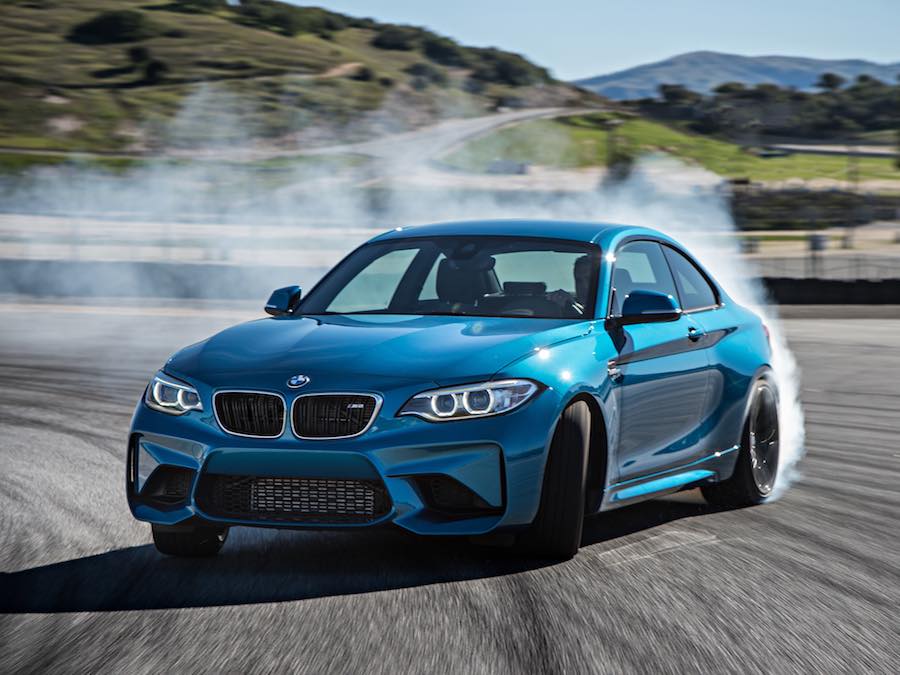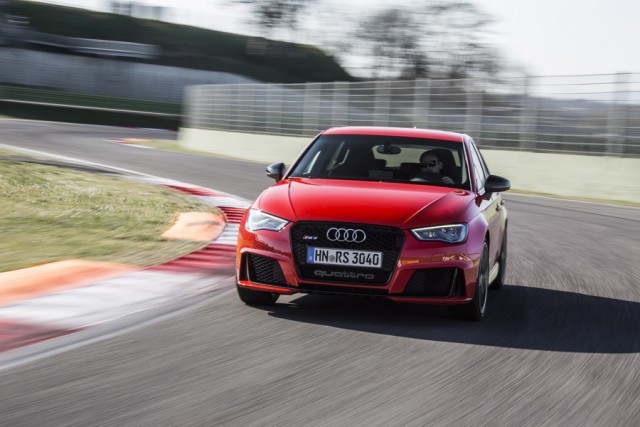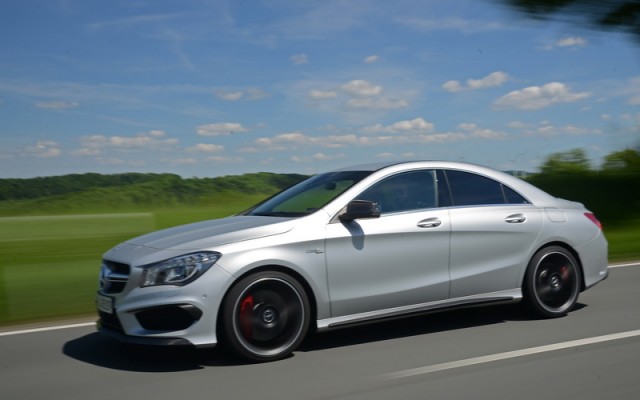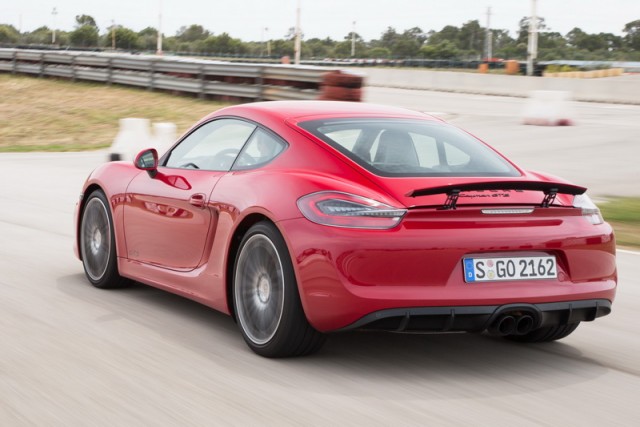The BMW M2 Coupé costs about twenty grand less than its big brother, the BMW M4, yet it shares key components with that car. Despite that, the M2 takes a relatively simple approach to things, eschewing too many settings or options in a refreshing back-to-basics tactic from BMW M. On this occasion, is less more?
In the metal
Although the BMW M2 features the traditional M car styling cues (quad exhausts, check; deep-set front bumper with more holes than bumper, check; prominent 19-inch alloy wheels, check) the visual makeover doesn't include any obvious aerodynamic add-ons. Saying that, the vertical slits you see at the extremities of the front bumper are referred to as Air Curtains by BMW, and they channel air around the front wheels. BMW attributes a 35 per cent reduction in lift (technically the opposite of downforce) to those and other aero tweaks. But it's only seeing the car in the metal for the first time that you truly appreciate how muscular it is in comparison to the regular BMW 2 Series Coupé, even the sportiest yet, the M235i. That's mostly thanks to significantly wider tracks front and rear (55- and 80mm respectively), foisted upon the car by the use of the BMW M3/M4's rear axle and gorgeous 19-inch forged alloy wheels. The latter do give the car a 'jacked-up' stance from some angles, but overall the shape is highly successful, with some neat design nods to icons of the past, such as the BMW 2002 Turbo, the 3.0 CSL and, more recently, the much-loved 1 Series M Coupé.
There's nothing radical about the M2's cockpit either, though it's well-judged. Black sports seats upholstered in Dakota leather with blue stitching stand out, while their headrests (and those in the back) are embossed with the M logo. Front seat occupants benefit from adjustable side bolsters, meaning you'll be held comfortably in place no matter how big your bones. There's an M footrest too, plus a soft kneepad for the driver on the centre console that you'd miss if it wasn't pointed out to you. The M-logoed gear lever and lovely three-spoke steering wheel are more obvious, as are the bespoke M2 instruments. Those familiar with the M3 and M4 will notice that there are far fewer driving system buttons clustered around the gear shift. We'll come to that in a moment.
Driving it
Let's start with the engine, which is exceptional, yet not the most impressive aspect of the M2's make-up. It's a turbocharged 3.0-litre inline six-cylinder unit producing 370hp at 6,500rpm and 465Nm of torque between 1,400- and 5,560rpm. It actually 'overboosts' for short periods between 1,450- and 4,750rpm to 500Nm, which explains why it feels utterly impossible to catch the engine napping. It always responds keenly and can accelerate from almost idle to the redline in sixth gear without too much grumbling or hesitation. This flexibility means it suits those that like to short-shift up through the gearbox as it does those that like to test the rev limiter.
It's worth noting that the M2's single-turbo engine is not the same as that in the twin-turbocharged M3/M4, though it does borrow some choice components from its big brother, such as the pistons and crankshaft main bearings. It sounds quite different too, if still obviously a turbocharged six-cylinder unit. The exhaust growls menacingly from idle and yet BMW still felt the need to augment the engine's sound using the speakers inside the car - though we're assured that it's to a small level. In fairness, it sounds fantastic from outside.
Buyers can choose to have a six-speed manual gearbox or the seven-speed M DCT dual-clutch automatic. There's little to choose between them in terms of price as the latter has a lower CO2 rating, so it's down to personal choice (and the annual tax bill). The auto is really good, allowing smooth operation when required or downright violent gearchanges when everything is turned up to 11. The gearchange paddles are perfectly weighted and highly responsive and who doesn't love a gratuitous throttle blip on the down-change? However, we'd put our money on the manual. It's a deliciously short and slick change with a genuine well-oiled mechanical feel through the lever. The pedals are also ideally weighted and spaced so it's huge fun to try to perfect your heel-and-toeing skills.
Except BMW includes a rev-matching facility by default, which negates the need to do this. It does work well, helping to stabilise the car, and if you also blip the throttle while changing down the system seems to recognise this and doesn't add more throttle on top. Nonetheless, we'd like the option to turn it off. Thankfully, toggle into Sport+ mode and it's gone. There are just three settings to choose from in the Driving Performance Control (DPC) system - Comfort, Sport and Sport+ - and, unusually for an M car, not much else to tweak. Adaptive dampers aren't even on the options list, which reveals how confident BMW M's chassis engineers are in its standard set-up. In fairness, the DPC system alters a lot, from the throttle map to the power steering weighting and the Dynamic Stability Control (DSC) threshold.
Unlike the M3/M4, which take a little learning and judicious use of the 'DSC Off' setting, the M2 proves to be highly trustworthy at and on the limit of adhesion and there's no fear in turning the DSC off in the dry if you know what you're doing. We got the chance to fully explore it on track and it's a wonderfully adjustable chassis, yet one that flatters the driver, allowing all skill levels to enjoy it to the full. Driving smoothly, it rewards with direct and communicative steering, ballistic performance and an obedient nose. Even after eight hard laps of the challenging Laguna Seca race track the brakes remained strong and though the tyres were clearly hot, the front end resolutely refused to understeer.
In Sport+ mode, the DSC is automatically switched into M Dynamic Mode (MDM), which BMW says allows controlled drifts on track. It does work well when lapping quickly, allowing just the right amount of slip at the rear axle on the exit of tighter turns to help maintain momentum out of the corners. But it needs to be switched off if you want to really drift. And the M2 proves to be hilariously simple to power slide around on track, with plenty of steering lock, a responsive throttle and a little something called the Active M Differential. This is shared with the M3/M4, but it has been thoroughly reprogrammed for the M2 and we're told that it is what gives the new car its unique driving talents.
We followed up the track work with a few hours on the road. Somehow we found a back road in California that bucks and weaves through the countryside as severely as any in Ireland, with plenty of nasty ridges, dips, crests and potholes. All we were missing was mud from tractor tyres and some rain... Here the M2 was even more impressive than it was on track. The road was narrow and had many a corner blind, yet the BMW scythed through it, making it a doddle to maintain indecent pace in safety, all the while revelling in the feedback and ability of the chassis underneath. It feels more like a biddable hot hatch at times so responsive to direction change is it, though no hot hatch can give that thrilling rear-drive attitude out of tight corners (maybe the new Ford Focus RS). While the suspension is quite firm, it also deals with bumps with ease, shrugging them off and getting on with putting its power down. I honestly can't think of another car that would have been as well suited to that particular piece of road. Can't wait to try it out here in Ireland.
What you get for your money
Although the M2 is expensive to buy (€78,370 on-the-road for the manual model, or €78,916 for the DCT auto), it is very well equipped, including Xenon headlights, Professional Media Package, satnav and more. There aren't as many options as you'd expect either, as BMW M wanted to keep the car simple. It's a shame that the manual version costs so much more than the auto to tax due to its higher CO2 emissions (€1,200 vs. €750). Still, the M2 is over €20,000 cheaper than the BMW M4, which makes it a bargain in our books.
Summary
We'll acknowledge that we have yet to try the new BMW M2 in wet weather or on slippery surfaces, but first impressions suggest that it'll be a lot better suited to Irish roads than its big brothers, the M3 and M4. It's a much more forgiving car to drive, flattering its driver yet remaining thoroughly engaging in the process. It looks great, is perfectly sized and though it's not cheap to buy, the end result is one of the most rounded cars yet to come from BMW M.


















































